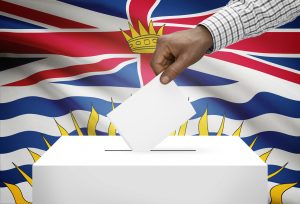The vote is being held by mail between October 22 and November 30
By Chandler Walter, Contributor
BC residents will have a decision to make this fall that will lay the groundwork for larger decisions down the road.
A province-wide referendum is being held between October 22 and November 30 to determine if the Government of British Columbia should keep the voting system the same or change it to one of three alternatives.
Electoral reform has long been a talking point during both provincial and federal elections in the past, most notably during Prime Minister Justin Trudeau’s 2015 campaign. Though there does not appear to be any sign of electoral reform coming into effect on the federal level, the provincial government has pushed the issue to a referendum, allowing British Columbians to have their say about how they cast their ballots.
The alleged need for reform comes primarily from weaknesses observed in the province’s (and country’s) current first-past-the-post (FPTP) system—wherein the candidate who reaches a certain number of votes first is elected to represent that district.
In a report from the attorney general titled “How We Vote” and published by the Government of British Columbia, the FPTP system is described as not usually producing proportional results, as “a political party’s share of the popular vote does not match its share of seats in the Legislative Assembly.” This is due in part to electoral districts where one party wins by a significant margin of voters, yet if an opposition party wins closer races and, eventually, more districts, it could result in a majority government in power that had not received the majority of the overall votes.
This system, according to the report, can often result in single-party majority governments and heavily favours large political parties over smaller parties or independent candidates.
The three alternatives that British Columbians will have the opportunity to vote for in the upcoming referendum include Dual Member Proportional, Mixed Member Proportional, and Rural Urban Proportional Representation (also known as Flexible District PR).
Dual Member Proportional would amalgamate much of province’s single member electoral districts with an adjacent district to allow for two members to come from the one expanded area. Two members from each party would be elected to each district, and voters would cast just one ballot for a pair of candidates. Seats would be won first by the party that receives the most votes in the district, and second based on province-wide voting results.
Mixed Member Proportional would elect candidates from single-member electoral districts (as is the current case) but would also elect additional members based on the results at regional or provincial levels. Districts would have to be made larger as there would be fewer members voted in through the district format, but it would make the distribution of seats more proportional to the provincial total by electing roughly 40 percent of members based on the province-wide vote.
Rural-Urban PR utilizes the Single Transferable Vote system for urban and semi-urban areas, and then uses the Mixed Member Proportional system in rural areas. The Single Transferable vote means that voters would rank their candidates in order of preference, and if the person they placed as their first choice does not have a chance of winning, their vote will then be transferred once to the next candidate in line instead. This allows for voters to back an independent or smaller party candidate without the worry of “throwing away their vote.”
More information on each of these systems can be found online through Elections BC’s website.
Potential voters for the referendum can register by going to elections.bc.ca/ovr, or by calling 1-800-661-8683 during business hours. They will then be mailed a referendum voter package by November 2. If a person has not received a package by November 2, they will be able to request one up until November 23 through the channels listed above.
“Make sure you are registered and that your information is up to date, especially if you’ve never registered, moved recently, or changed your name,” said Anton Boegman, the Chief Electoral Officer for Elections BC, in the release. “If your voter information is current, you will get a referendum voting package in the mail later this fall.”
All BC residents who have lived in the province for at least six months, are 18 years or older as of November 30, and are a Canadian citizen can vote in this referendum.



